– The innovative concept of just plan it –
Small job shops and especially those with a strong focus on customized products have a hard time creating a reliable production schedule. There are many reasons for this.
This ebook reveals why these small make-to-order companies stumble when battling the daily production schedule. As a production planner, or manager, you will recognize yourself in this book and you will learn how you can create a reliable production schedule in just a short time, and keep full control of the shop floor.
It provides insight into just plan it's unique scheduling concept and how it helps high-mix low-volume manufacturers grow.
;-)
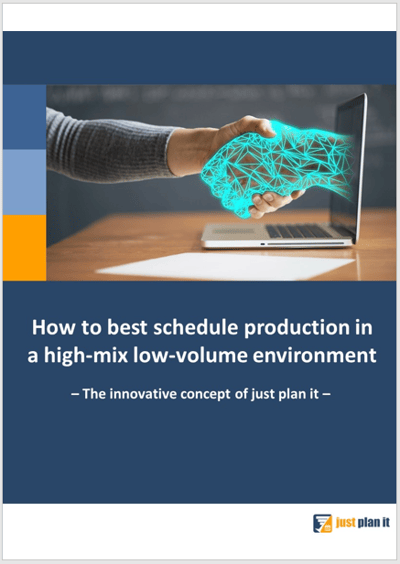
just plan it is a cloud-based production scheduling tool that is 100% focused on the scheduling needs of small and medium job shops or high-mix low-volume manufacturers (in short HMLV). just plan it’s innovative concept is based on two pillars
- A powerful, interactive planning board that gives the planner a full overview of production orders and resource allocation. It allows direct intervention on the schedule.
- A scheduling engine that automatically determines the highest possible throughput, considering the individual priorities of the production orders. It schedules and reschedules orders quickly by considering finite capacity.
just plan it’s goal is to provide the planner with an agile tool in a very dynamic scheduling environment that significantly reduces his workload through automation, while still allowing him to control the plan manually via a variety of intervention options.
The software is an all-in-one solution: it creates the production schedule, generates the corresponding work plans for the employees, and includes a feedback system from the shop floor.
.png?width=1000&name=MicrosoftTeams-image%20(26).png)
just plan it
Our legacy is the development of Gantt chart software. In the past decade, we narrowed our focus and turned our Gantt chart software expertise into developing visual scheduling software for small and medium-sized companies to increase operational agility. In this context, we work with a great many companies from the manufacturing sector.
Again and again, however, we have been approached by small companies that manufacture very customer-specific products and were unable to find a suitable solution for their order-oriented production scheduling, even though the market for scheduling software is very large.
Over time, six basic requirements crystallized for us, which software must offer to be a real support for this very dynamic production process of a high-mix low-volume manufacturer. With these basic functions in mind, we then developed just plan it, a specific software solution, which we continue to develop today in close cooperation with our customers.
.png?width=966&name=MicrosoftTeams-image%20(25).png)
Let's briefly try to understand what sets just plan it apart from other scheduling tools. This is best achieved by understanding what differentiates HMLV manufacturers from low-mix high-volume (LMHV). The difference between these two types of manufacturers drives different needs for production scheduling (software).
LMHV manufacturers sell mass products, i.e., products of the same type in large quantities. Instead, the products of HMLV manufacturers are planned according to the individual needs of their customers. They are manufactured in small quantities.

LMHV manufacturers have a long planning horizon - they often have long customer relationships with regular acceptance of their products. They know their market well and can make forecasts about future sales. The high level of automation in this manufacturing process reduces the use of labor. The operations are relatively consistent. Due to the high use of machinery, the data quality that can be obtained in the production process typically is very high. Approaches to optimization lie, for example, in a reduction of set-up times, reduction of inventory costs, and improved machinery use. In this case, for example, an improvement in machine occupancy, even if it is only in the cent range, can have a high savings effect because of the high number of pieces.
In contrast, the manager of a job shop or HMLV manufacturer never knows exactly when the next order will arrive and what its production structure will look like. This means that the planning horizon is very short, and the production structure per order is very complex and individual. Therefore, a good overview of the entire order network with all its operations and dependencies is hard or even impossible to achieve. Rescheduling is a standard task for the planner, and on the other hand, he must always make sure that delivery dates are met. The overall environment of the HMLV manufacturer is much more volatile and unstable compared to the LMHV producer.
HMLV manufacturers are usually not very digitally oriented, i.e., their data situation is very imprecise. They often still plan roughly with paper and pencil, or with Excel.
Employees of an HMLV manufacturer play a crucial role in manufacturing because assembly tasks and operating or setting up a machine are a large part of the production process. They are typically very well trained and versatile.

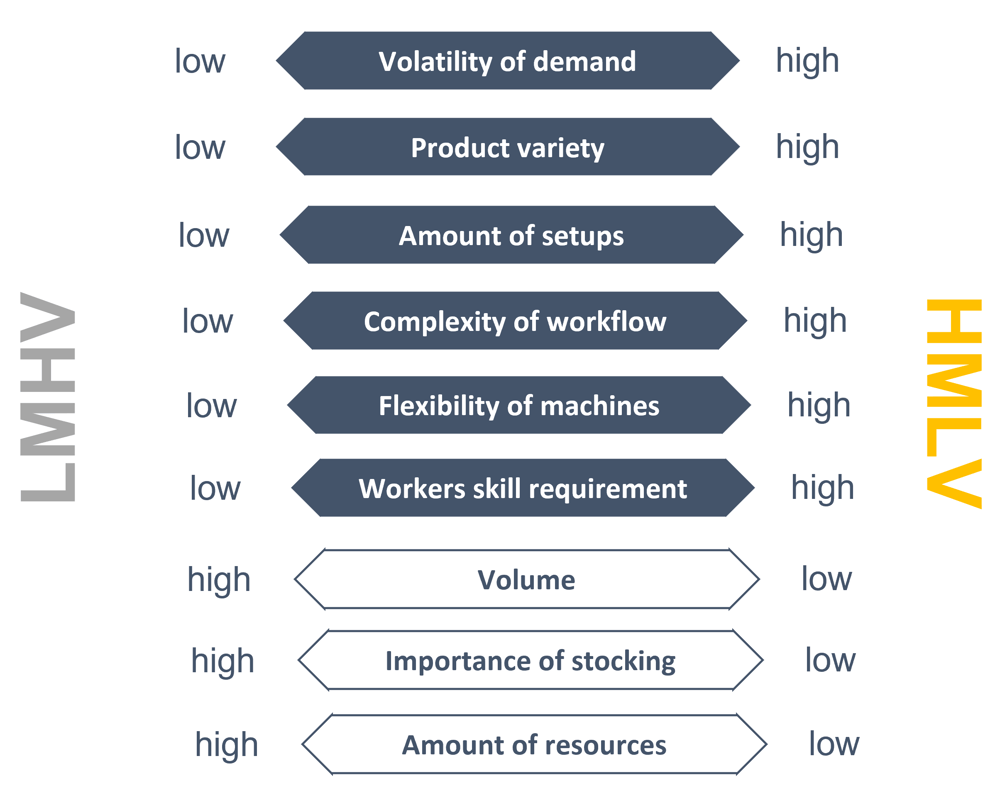
The above-mentioned differences in the production processes result in different scheduling requirements. Consequently, scheduling software must be completely different if you want to determine the production order sequence for either LMHV or HMLV manufacturers.
Since the planning environment is very stable for LMHV manufacturers, reliable input data can be generated. This applies both to incoming orders and to the duration of operations and resource allocation. Optimization solutions for this given planning environment can be easily calculated using mathematical heuristics. The software's specifications as to when which task is to be executed in which batch size is then a fixed specification for production.

We have seen above that this stable planning environment is lacking when it comes to HMLV manufacturers. Accurate input data also exists just to a small degree. Digitization in the production process is not very advanced and data collection of shop floor progress is usually non-existent. Inaccurate data leads to inaccurate calculations. Hence, optimization calculations are not realistic or even prove to be outdated after a short time.
It is more important for HMLV manufacturers to be able to react efficiently and effectively to the dynamics in the schedule with the help of software. This includes the planner being able to quickly find production orders that run in danger to be late and identify bottlenecks or capacity gaps. If he gets this information quickly, he can make rescheduling decisions easier. Then, a good HMLV scheduling software should automatically recalculate the entire production order network including the resulting resource allocation.
just plan it’s goal is
> to make high-mix low-volume production scheduling transparent.
> to increase throughput and adherence to delivery dates.
> to be able to adjust the schedule and easily reschedule.
> to be accessible via the internet and be maintenance-free.
To achieve this, we have carefully studied the specific scheduling needs of HMLV manufacturers and derived the following
6 basic functions, according to which we have developed just plan it:
Basic function 1:
The centerpiece: We use Gantt charts for the production order and resource allocation overview. With this, we visualize the production orders, their individual operations, and the resource allocation using bars along a timeline. The planner can look at the data from 3 different views within just plan it, i.e., the same data is displayed in 3 different charts:
Resource view: On this view, the planner sees which resource is scheduled to work on which task and when. It creates an overview of the capacity utilization and shows gaps.

Resource group view: Resources are often combined in groups, in which different resources can take over the same tasks, like a group of different CNC machines with the same functions. With this view, the planner can see which resources in the group still have free capacity to take on additional tasks if necessary, or when the group, and thus the work step, is too busy and hence becomes a bottleneck.

Production order view: the focus here is on the production orders, which are laid out in the form of a priority list. Symbols for release dates and delivery dates indicate the period in which the order must be processed and how far a postponement is possible without jeopardizing punctual delivery.
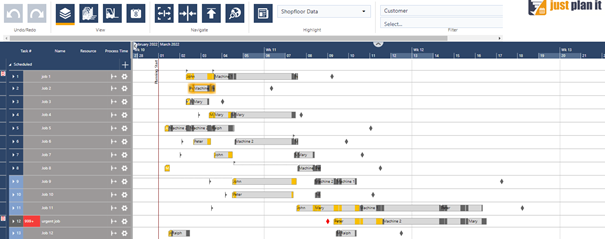
The Gantt charts in just plan it are of course equipped with all kinds of visual support such as links for the predecessor and successor relationships, warning signals when delivery dates are exceeded, simple time scale zooming, and much more that make it easier for the planner to read the data, get an overview and make decisions when rescheduling. Operations, resources, and orders can be easily moved via drag & drop and deeper data templates can be edited via a mouse click.
Since visualization is at the core of NETRONIC's DNA, there is probably no HTML5-based planning board that has better visual features and interaction capabilities than just plan it 😊.
Basic function 2:
In simple terms, just plan it’s scheduling engine considers resources as the limiting factor in the system, and distributes the operations on it considering the following 3 principles:
Principle #1: just plan it calculates with finite capacities and allocates the resources so there is no over-loading.
Principle #2: The engine calculates according to the ASAP method by default, i.e., it looks for the earliest time at which the order can start. This can be, for example, a release date set by the planner, when the necessary material for the order is delivered, or simply from the time the planner releases the order. The scheduling engine looks for the resource combination that can complete the operations at the earliest possible time with the given resource allocation.
Principle #3: Jobs are scheduled according to priorities. The production order with sequence number 1 has the highest priority and it takes precedence over all other orders in the allocation of resources.
"Before we had just plan it, it took us a day to make production schedule changes to one project. It was not fast enough, and it was not automated. Now, we can update multiple projects at the same time, and it takes less than 45 minutes”, Zac Carey, Production Scheduler at PK-30 Systems

For example, the planning board indicates that a production order cannot be completed in time under the currently scheduled resource allocation. The planner has several options for action: he can assign a higher priority to the order by decreasing the sequence number, i.e., resources are assigned to this order in a prioritized manner, resulting in earlier processing and thus an earlier delivery date. Alternatively, he can also increase the resource capacity at a bottleneck point, e.g., by asking an employee for extra work, or by outsourcing intermediate operations to a subcontractor. He can just as well decide to accept the delayed delivery date and inform the customer about the delay beforehand. He decides what is the best solution in each case regarding the overall plan or considering his contractual situation with the affected customer.

And this is exactly where just plan it's innovative concept for production scheduling for HMLV manufacturers comes into its own - the perfect interaction between the scheduling engine, the planning board, and the manual intervention option:
Basic function 3:
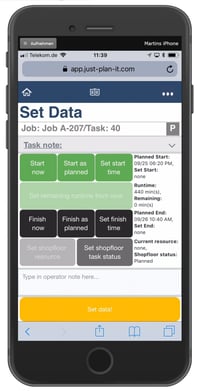 Does it make sense to draw up a plan without knowing how the plan is executed? Of course not. Therefore, just plan it not only creates work plans for the employees, which are displayed on tablets or mobiles, but at the same time, they also receive a simple menu with which they can give feedback to the system, such as work order started, interrupted, completed. The data can be fed back in terms of time or quantity.
Does it make sense to draw up a plan without knowing how the plan is executed? Of course not. Therefore, just plan it not only creates work plans for the employees, which are displayed on tablets or mobiles, but at the same time, they also receive a simple menu with which they can give feedback to the system, such as work order started, interrupted, completed. The data can be fed back in terms of time or quantity.
This way, real data is fed back into the system, providing the planner with an up-to-date report on the schedule, alerting him in case of unplanned delays, and enabling him to take corrective action in good time.
“The most important features for me were the ability for engineers to log on and off tasks and update the schedule in real-time.” Richard Loynds, Managing Director at Loynds International Ltd
In addition, this data can later be used for a target/actual comparison to find errors in the template data. The planning is successively made more precise.
“Thanks to just plan it, we are also able to measure the productivity of each area and draw conclusions from the data it gives us. From there we have been able to reassign certain people to other areas and we have discovered bottlenecks that we didn't know were so important." Jerónimo Álvarez, Senior Director Manufacturing at Cortinas México
Basic function 4:
The flexibility and good training of the workforce were already mentioned at the beginning as a special feature of HMLV manufacturers. On the other hand, the workforce's capacity is the system's limiting factor. So how can the high flexibility of these resources be converted into the best possible utilization? In just plan it, the skills required for each work step are defined, and at the same time, the skills of each employee are stored. Based on this skills matrix, just plan it can enormously increase its combination options in terms of resource assignments, which leads to the most even and optimal utilization of all resources.
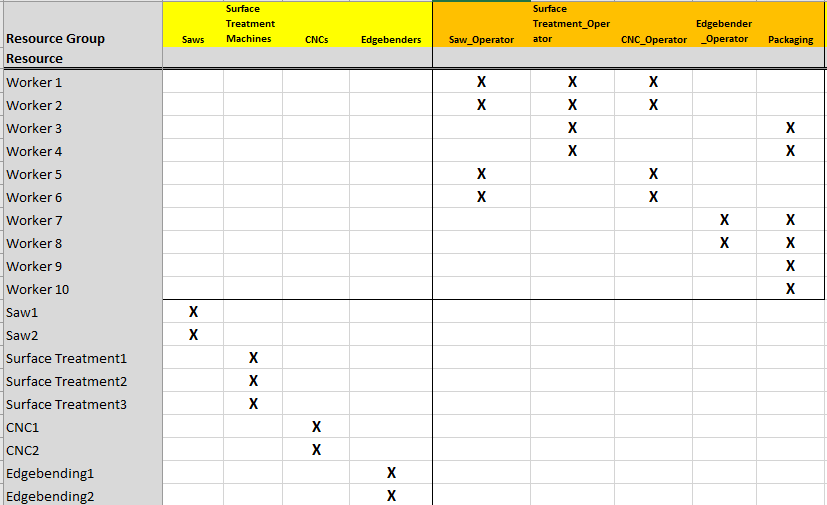
“We had a 30 to 40% increase in productivity in week one. The return on investment was within 1 or 2 months.” Ross Larner, Operations Director and Co-Owner of Panaltech
Basic function 5:
Small manufacturers have little time and money to spend on introducing a complex software tool. Therefore, at just plan it, we have placed great emphasis on ensuring that
- The implementation process is short and personal. One of our experts personally coaches each new customer, to ensure the best possible benefit of using the software.
- The implementation and use of just plan it is affordable for small businesses. We offer both the launch and the annual usage fee as fixed prices at fair conditions.
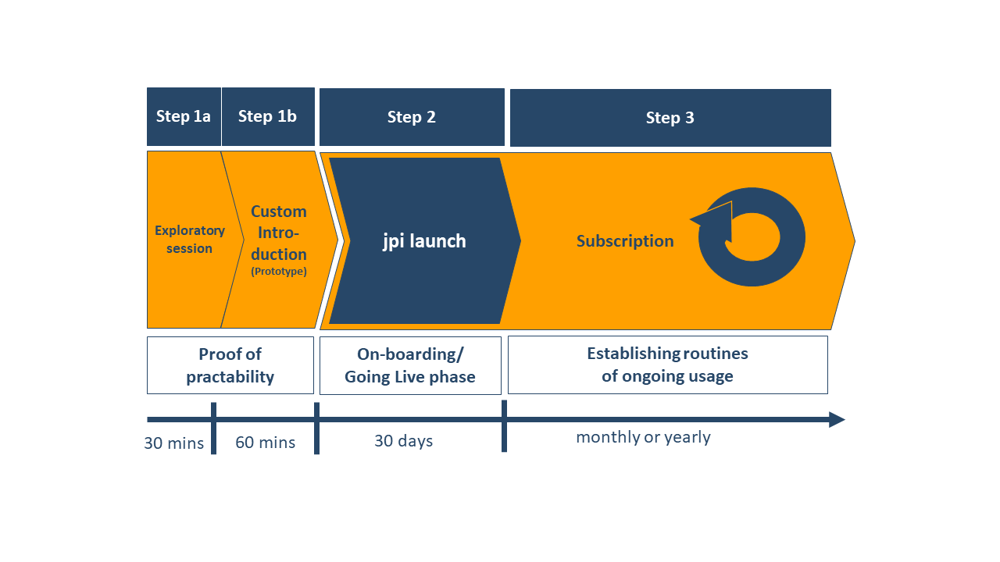
"JPI met our expectations as soon as we started using it. It is the most user-friendly solution available. It took us under two weeks to completely migrate our scheduling to JPI. The JPI team was an invaluable resource and helped to get our company’s system hooked up with JPI in order for us to do automatic data dumps." Guillermo Cardoso, Global Supply Chain Manager of Canada Rubber Group Inc.
Basic function 6:
Finally, the principle: Data should never be held twice. just plan it offers an open API. With this, interfaces to all third-party systems, like ERP systems, can be programmed. We have experience with the connection of numerous ERP systems, such as Infor, Sage, Epicor, Strumis, Microsoft Dynamics GP, JobBoss – just to name a few. In addition to the connection of ERP systems, just plan it can, of course, also couple with BI software or proprietary shop floor tracking systems. For those not yet working with any software, just plan it can also be used as a stand-alone web-based solution that will continuously be updated and maintained.
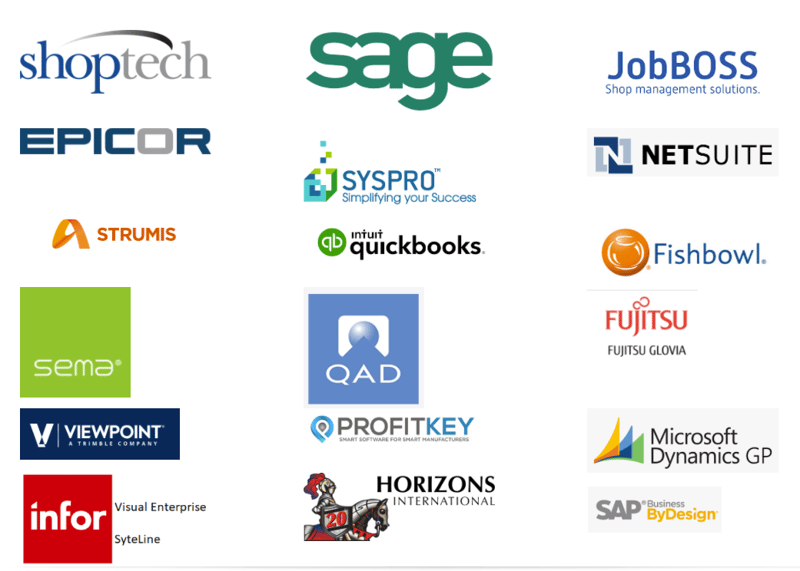
It is certainly clear to all SMB manufacturers today that no growth is possible without transparency regarding the current and planned production schedule.
Since digitalization has long since reached the world of small production companies, the corresponding use of modern technologies in scheduling is more than evident. For HMLV manufacturers, Excel can only be the first step on this path. However, searching for a suitable production scheduling software is usually difficult for them. Time reasons but also the reflection on the own requirements for suitable software are a substantial stumbling block in the conversion of small enterprises.
This short e-book can hopefully help HMLV manufacturers become clear about what form of digital support they need and what they should look for when selecting the right scheduling software. Here is your wrap-up:
HMLV manufacturers need production scheduling software, that
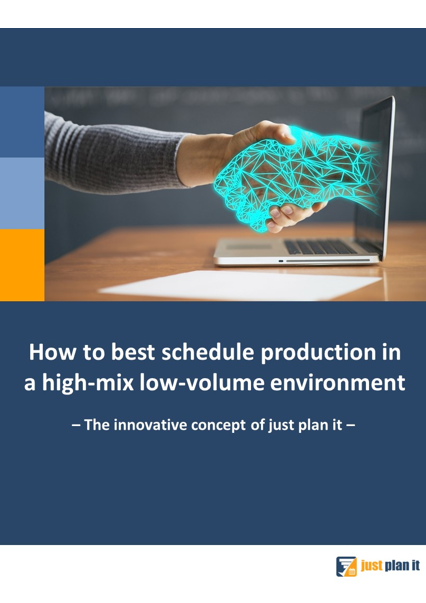
Last note:
If one of these sayings applies to you:
“Production scheduling is a nightmare” –
“We are taping in the dark” –
“Production scheduling is just chaotic fire-fighting” –
“It is so stressful” ….
then contact us. We will help you.
"With the use of just plan it, we started working in another, more effective way." Tom Castermans, CEO at Tenco

Made with by BOYUM IT SOLUTIONS GmbH (Copyright © 2024) Read our Privacy Policy & Terms of Service